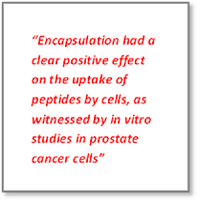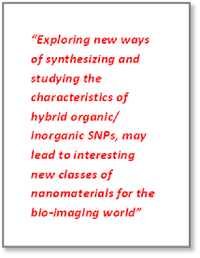 In this thesis non-covalent, most notably electrostatic, interactions are taken into account in the formation of supramolecular nanoparticles (SNP) that form a novel and powerful tool for new developments in nanomedicine. This important aspect is essential in order to understand SNP (dis-)assembly mechanisms, kinetics and stability.
In this thesis non-covalent, most notably electrostatic, interactions are taken into account in the formation of supramolecular nanoparticles (SNP) that form a novel and powerful tool for new developments in nanomedicine. This important aspect is essential in order to understand SNP (dis-)assembly mechanisms, kinetics and stability.
The formation of cyclodextrin (CD)-based SNPs, and their biomedical applications, are studied. The size and stability of the negatively charged linear polymer poly(isobutyl-alt-maleic acid) are controlled; by a balance between attractive host-guest and repulsive electrostatic interactions.
‘While working on these processes, to our surprise we observed, that these particles were stable without the use of a monovalent capping agent,’ says Laura Grana Suarez. ‘Furthermore, the particles were becoming smaller when positive charge was introduced. We shared this experience with the rest of the Molecular Nanofabrications (MNF) group and focused our research efforts from there. It turned out to be a crucial moment in my PhD project.’
Also the effect of loading a fluorescent heavily charged cargo into the SNPs - making therefore these SNPs fluorescently visible - has been investigated. ‘The environment inside the SNPs changed from negatively to positively charged,’ says Laura. ‘This affected the particle size and stability.’

As a next step, pH-sensitive peptide uptake and release systems were developed, based on these negatively charged fluorescent SNPs. It appeared Fluorescent Resonance Energy Transfer (FRET) served as a good sensor to study the encapsulation and release of the peptide cargo. It showed that the release occurred at pH values resembling body-like lysosome conditions.
‘The encapsulation had a clear positive effect on the uptake of the peptides by cells, as witnessed by in vitro studies in prostate cancer cells,’ Laura was able to conclude.
Luminescence properties

In the second part of the thesis the formation of hybrid organic/inorganic SNPs based on lanthanide-doped nanoparticles was described. By changing the dopand lanthanides, the luminescence of the SNPs could be changed from blue or green emitting down- to up-converting. Further: different assembly properties resulted in different effects on luminescence properties.
‘These findings are of utmost importance for therapeutic applications,’ Laura beliefs. ‘This is true for drug and gene delivery. Exploring new ways of synthesizing and studying the characteristics of hybrid organic/inorganic SNPs, may also lead to interesting new classes of nanomaterials for the bio-imaging world.’
Collaborations
In this research, primarily the lab facilities at Mira Biomedical Technology and Technological Medicine were used. Mesa+ facilities were important as well, especially the Scanning Electron Microscope.
‘Also collaboration with Dr. Fijs W.B. van Leeuwen (Leiden University Medical Center) was central,’ Laura says. ‘Further, the last two chapters were performed in collaboration with dr. Shyam Sarkar and Dr. Venkataramanan Mahalingam, from the Indian Institute of Science.’
In this PhD work experimental work and designing novel experiments were most important. ‘The first part of the project was the most difficult one,’ Laura says. ‘After that I proceeded much more easily. The loading encapsulating part was more interesting and specific, leading to nice results.’
Industry

Laura: ‘I developed my skills in various ways. After this academic period I prefer to broaden my experience, preferably in industry - although a challenging PostDoc could fit as well - and make good use of my experimental skills. Perhaps one day I will return to academics with a fresh mind, knowing about the industrial needs and inspire my research from there.’
